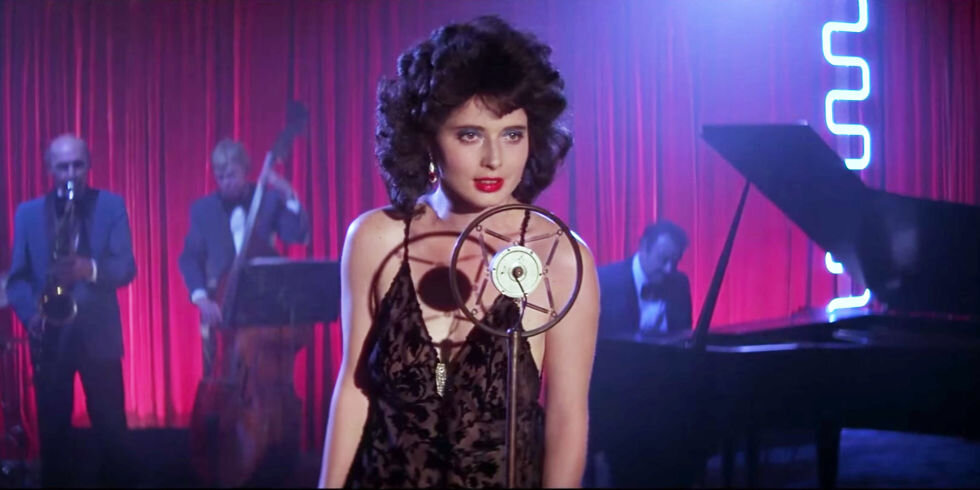
★★★★½
Directed by David Lynch
Starring - Kyle MacLachlan, Isabella Rossellini, Dennis Hopper, Laura Dern
Blue Velvet (1986)
Written by Dalton Welsh - June 30, 2020Director David Lynch has often been credited as having one of the most distinctive creative visions in all of film, never afraid to display his unique brand of weirdness and eccentricity. The way this style complements the psychological thriller genre is fantastically executed in his 1986 film “Blue Velvet”. Following the story of college student Jeffrey, who’s curiosity gets the better of him when he gets involved in investigating a potential murder in his neighbourhood, leading him into the local criminal underbelly. With some truly impactful performances occupying a nostalgically embellished production, Lynch’s tale gives true insight into the glamorization of murder mysteries and the dark side of suburban America.
The opening shots of the film portray idyllic, quintessential, suburbia, with bright flowers, unnaturally green grass, clear skies, and white picket fences. However, within these embellished streets we witness an elderly man suddenly take ill and fall motionless whilst his gardening hose continues to run. This introductory scene acts as an inventive microcosm of the films overarching theme, that even the most unassuming and innocent appearing places can in a moment unearth darkness. With our protagonist Jeffrey personifying this, as his innocence is taken away by the corrupted and the malevolent. From this we realise the story isn’t so much about solving the mystery at the film’s core, but how our central characters are affected by its surrounding evil.
Speaking of the films characters, they aren’t just placed in this scenario haphazardly, their arcs are intertwined with the themes of the film. Kyle MacLachlan excellently and charismatically portrays the anxiety and naivety of Jeffrey as he finds himself face to face with the film’s villainy. His supporting star Laura Dern as Sandy acts as a great juxtaposition to Jeffrey’s character change. While they both begin equally naïve to this world of drug use and sadomasochistic violence, Jeffrey’s eventual exposure to it makes for a great contrast to Sandy’s continued blissful ignorance. Furthermore, while some may find some of the dialogue that these two share to feel cheesy and stilted, I feel this unnatural dialogue adds to the unnerving aura of the film. Even before the film begins to thematically darken, this unconventional dialogue creates a sense of foreboding abnormal dismay. Additionally, the other central characters, Isabella Rossellini as Dorothy, and Dennis Hopper as Frank, give the two best performances of the film. Rossellini hauntingly conveys the tormented and tragic nature of Dorothy with great emotional intensity. While Hopper has an exceptionally unnerving, demented and frankly demonic screen presence as the frightening Frank Booth.
Then there is the film’s presentation. The production makes heavy use of 1950’s aesthetics, particularly noticeable in the costuming, indicative of the films parallels to noir films of the era with its femme fatale in Dorothy and the insurmountable villain in Frank Booth. This noir parallel can also be seen in the often dark and shadowy cinematography. Which Lynch intriguingly combines with another 50’s aesthetic in oversaturated colours. The bright yellows, blood reds and deep blues when mixed with this shadowy lighting fuels the psychologically challenging style of the film. This abundance of oversaturated colour implemented to the point where it feels effectively sickly.
This influence of the styles of yesteryear can also be felt in the music of the film. While the idea of playing more innocent music atop scenes of violence and distress to establish interesting contrast has been done many times before, Lynch still manages to make it feel uniquely intriguing. While other films use this technique with little additional basis, this music is intertwined with the overall 50’s influence. Particularly with the use of the title theme “Blue Velvet” released in 1951, accompanied by a selection of other songs from the 1950’s. While before these songs may have had more uplifting tonality, Lynch is such an expert communicator of bizarre and uneasy temperament that these song take on a whole new connotation. To the point where the songs both contrast the films mood in their original intent and compliment with their new application.
So, with a bevy of strong performances particularly with Rossellini’s poignantly emotional portrayal of Dorothy and Hopper’s discomforting and unnerving display as Frank Booth. Blue Velvet presents to its audience a look behind the curtain at the lie of suburban America, that it can be just as dark and twisted as the most evil ridden corners of the world. Communicated with great attention to purposefully nostalgic aesthetics in its costuming and colour palette. Surrounded by a 50s centric score that while initially contrasting the films temperament, through its frequent juxtaposition to scenes of absurdity and dismay turns its connotations to elevates the communication of the films tone. Making for a holistically unnatural experience, orchestrated with great idiosyncrasy by master director David Lynch.
